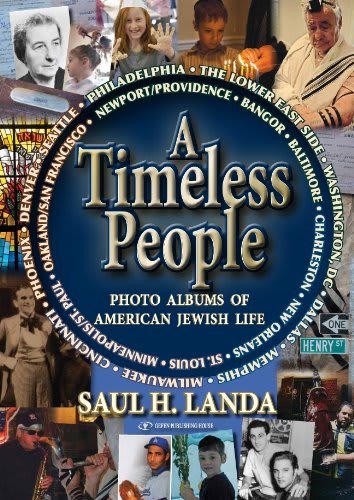After attending the Orthodox Union’s first Emerging Jewish Communities Fair in 2006, Dr. Saul Landa, a New Jersey dentist with a passion for photography, was inspired to publish “A Timeless People” (Gefen Publishing); highlighting the history of 18 Jewish communities across America. Dr. Landa’s four-year odyssey resulted in a coffee-table sized book of 380 pages with more than 1,000 photographs (a combination of photos taken by the Dr. Landa and archival images from the featured communities), which he dedicated to the Orthodox Union. The following is an exclusive excerpt:
History has long ago taught us the undeniable truth: to understand a people today, you must first understand its past. Or, as Walter Ehrlich put it in his book Zion in the Valley, “If you don’t know where you’ve been, you won’t know where you’re going.” For me the last four years have been a hands-on demonstration of this principle.
Before I started this odyssey, I asked myself the fundamental question: How have the Jewish people been able to persevere and maintain their devotion to the Torah for over 350 years in a country replete with unparalleled freedom, but (not coincidentally) equally replete with the most challenging of tests? What makes this people “timeless”?
Well, now we have traveled together on this journey. If we allow ourselves to be illuminated by the rabbis who say that the totality of experience of all Jews who preceded us is implanted in our very souls, then the answer begins to become clear to us.
Despite the passage of time since I began my travels, the vision of diversity of both the people and their stories of survival remains as transparent as a cloudless day.
There are the Sephardi Jews from Turkish Marmara, whose customs were unrecognizable to the European Ashkenazim; the Jew from the deep South or Southwest whose method of food preparation and cooking differs from those Midwest and North. From the eclectic, free-thinking, “opt-in” community of San Francisco to the intense Chassidic community of Milwaukee, Jews in America come in every style and form.
Yet despite this wondrous diversity there is, I realize, a common bond that binds us together.
A Jewish Confederate soldier, fatigued from so much death and devastation in his years battling the North in the Civil War, accepts an invitation from a Jewish “Yankee” family he passes, to enjoy a Passover Seder together.
A Holocaust survivor, just a few years removed from the unspeakable horrors, refuses to give birth in Washington, DC, until a live chicken is brought so she can perform the tradition of kapores before Yom Kippur.
New Orleans Jews open their doors to the Jews of Memphis fleeing a Yellow Fever epidemic in the 1870s and then, over 100 years later, the Jews from Memphis open their doors to the New Orleans victims of Hurricane Katrina.
Yes, this is a passionately committed people. Look at the faces of the people in this book. Look into their eyes. These are people who, through hundreds of years on American soil, have fought through incredible trials to maintain their traditions.
Do they seem familiar to you? They should: they are our parents, bubbes, zeides. They are, indeed, you and me. They are people, prime movers, who have kept their communities strong in Torah tradition throughout the years. While they might not necessarily be the “rich and famous,” there is nothing “common” about them.
Many chapters in the Torah were written about our forefathers Abraham and Jacob. However, few verses were devoted to the forefather in the middle, Isaac. Our rabbis tell us that, in reality, his role was the most crucial: to be the link in the chain to connect the beginnings of our religion to the next generation, that of Jacob (whose children would become the twelve tribes of Israel). Without this link, our world would be lost. In the “wilderness” of the American diaspora, this has been the role of all those you see in this book.
They are a diverse people indeed, but the commonality of purpose and devotion to the Torah and to each other has never changed. This is indeed a timeless people.
Visiting our people in these communities, learning of their travels and listening to their stories, has given me (and I hope you) incredible chizuk, strength. I realize (as I am told vehemently quite often) that there are many other communities quite worthy of being profiled. With your help and guidance, this certainly can become a reality.
We have seen but a small glimpse of the road our people have traveled in this country from past to present and stretching out to the future: life-cycle events and the emotions they evoke, holidays with their particular observances, customs and traditions. From the sad contemplation of Tisha B’Av to the joy of a wedding, from Yom Hashoah to Yom Ha’atzmaut, from the freedom of Passover to the redemption of Shavuos, we have seen the past and the future together. I hope you feel my joy!
Dr. Saul Landa has been a photographer of Jewish subjects for over thirty-five years. He is also an avid athlete, traveler and hiker, and throughout his life has explored the world, including summating Mount Killimanjaro.
An associate clinical professor in Dentistry at the University of Pennsylvania School of Dental Medicine as well as an ordained rabbi, he resides in East Brunswick, New Jersey, with his family.
Dr. Landa is available for guest speaking engagements and you are invited to contact him or provide information about your own community at: timelesspeople@gmail.com
The words of this author reflect his/her own opinions and do not necessarily represent the official position of the Orthodox Union.







